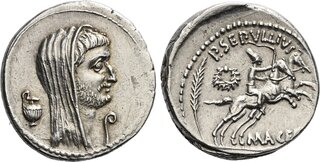| Numismatica Ars Classica > Auction 143 | Auction date: 7 May 2024 |
| Lot number: 386 Price realized: This lot is for sale in an upcoming auction - Bid on this lot  | Show similar lots on CoinArchives Find similar lots in upcoming auctions on |
| Lot description: The Dioscuri Collection. The Roman Republic. P. Sepullius Macer. Denarius 44, AR 18 mm, 3.74 g. Bearded and veiled head of M. Antonius r.; behind, jug and before, lituus. Rev. P·SEPVLLIVS – MACER Desultor galloping r., holding whip in r. hand and reins of second horse with l.; in l. field, wreath and palm branch. Babelon Sepullia 8 and Antonia 2. C 74. Sydenham 1077. Sear Imperators 142. RBW 1689. Crawford 480/22. Very rare. A superb portrait of excellent style and a lovely light iridescent tone. Reverse slightly off centre, otherwise virtually as struck and almost Fdc Ex NAC sale 92, 2016, 400. After the murder of Caesar on the Ides of March 44 BC, Rome was turned upside down. M. Junius Brutus, C. Cassius Longinus and the other Liberators believed that their act would be seen as the freeing of Rome from the tyranny of a would-be king and that they would be welcomed. They were shown to be wrong when the common people, many of whom had benefited from Caesar's largesse, rose up and burned down the Senate House. Two days later, Mark Antony, Caesar's lieutenant and leader of the Caesarean faction in Rome, offered a compromise to the Liberators in which they would not be punished but all of Caesar's political appointments would remain valid. This settlement avoided an immediate collapse of the government and allowed Antony time to marshal the Caesarean forces that were left reeling by the death of Julius Caesar. At Caesar's funeral, held on 20 March BC, Antony gave a speech that stirred public anger against the Liberators to such a degree that they soon decided that it was safer for them to leave Rome and Italy entirely. This denarius was struck by Antony not long after in the context of games included in the Paralia festival celebrated on 21 April 44 BC. The games were introduced to the festival to celebrate Caesar's final victory over the Pompeian faction at the Battle of Munda (17 March 45 BC) and were used to further focus public sentiment against his murderers. The reverse type depicts a rider whipping his horse into a frenzy of speed while a second horse gallops beside. This individual is known by the Latin technical term desultor, which refers to a popular type of acrobat who leaped from one horse to another at high speed. Roman desultores plied their trade in the circus to the amazement of the crowds and were easily recognised by the distinctive tall felt caps (clearly visible here) that they wore. The desultor here is thought to represent a participant in the Antony's games at the Paralia. Estimate: 8000 CHF |  |



